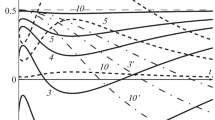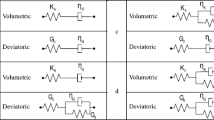Abstract—A physically nonlinear constitutive equation with four arbitrary material functions for isotropic rheonomic materials is studied to determine the rheological effects simulated by it and the spheres of influence of the material functions. The properties of the volumetric, axial, and lateral creep curves generated by this equation and the dependence of the lateral strain coefficient (Poisson’s ratio) on the material functions, time, and stress during creep are analytically investigated. A general exact estimate of the upper and lower bounds of the Poisson’s ratio and criteria of its negativeness, increase, decrease, and constancy are obtained. The Poisson’s ratio of the model is proved not to be a nonmonotonic function of time.


Similar content being viewed by others
REFERENCES
S. B. Aibinder, E. L. Tyunina, and K. I. Tsirule, Properties of Polymers in Various States of Stress (Khimiya, Moscow, 1981).
A. Ya. Gol’dman, Volumetric Deformation of Plastics (Mashinostroenie, Leningrad, 1984).
R. S. Lakes, Viscoelastic Materials (Cambridge Univ. Press, Cambridge, 2009).
N. W. Tschoegl, W. G. Knauss, and I. Emri, “Poisson’s ratio in linear viscoelasticity–a critical review,” Mech. Time-Dependent Mater. 6 (1), 3–51 (2002).
E. V. Lomakin, “Mechanics of media with the properties dependent on the state of stress,” Fizich. Mezomekh. 10 (5), 41–52 (2007).
D. J. O’Brien, N. R. Sottos, and S. R. White, “Cure-dependent viscoelastic Poisson’s ratio of epoxy,” Exp. Mech. 47, 237–249 (2007).
D. Tscharnuter, M. Jerabek, Z. Major, and R. W. Lang, “Time-dependent Poisson’s ratio of polypropylene compounds for various strain histories,” Mech. Time-Dependent Mater. 15 (1), 15–28 (2011).
V. D. Brekhova, “Poisson’s ratio of some polycrystalline polymers during compression at a constant load,” Mech. Polym., No. 4, 43–46 (1965).
I. Ya. Dzene and A. V. Putans, “Poisson’s ratio during one-dimensional creep of polyethylene,” Mech. Polym., No. 5, 947–949 (1967).
A. S. Savinykh, G. V. Garkushin, S. V. Razorenov, and G. I. Kanel’, “Longitudinal and volumetric compressibility of sodium–lime glass at pressures up to 10 GPa,” 77 (3), 38–42 (2007).
M. E. Kozhevnikova, “Cahnge in the plasticity zone boundary and Poisson’s ratio as a function of plastic softening,” Fizich. Mezomekh. 15 (6), 59–66 (2012).
S. Ozupek and E. B. Becker, “Constitutive equations for solid propellants,” J. Eng. Mater. Techn. 119 (2), 125–132 (1997).
H. Shekhar and A. D. Sahasrabudhe, “Longitudinal strain dependent variation of Poisson’s ratio for HTPB based solidrocket propellants in uniaxial tensile testing,” Propellants Explos. Pyrotechn. 36 (6), 558–563 (2011). https://doi.org/10.1002/preP.200900079
H. R. Cui, G. J. Tang, and Z. B. Shen, “Study on viscoelastic Poisson’s ratio of solid propellants using digital image correlation method,” Propellants Explos. Pyrotechn. 41 (5), 835–843 (2016).
I. Ya. Dzene, A. F. Kregers, and U. K. Vilks, “Deformation during creep and repeated creep of polymers during uniaxial tension. Part 1.” Mech. Polym., No. 3, 399–405 (1974).
R. Lakes, “Foam structure with a negative Poisson’s ratio,” Science 235, 1038–1040 (1987).
E. A. Friis, R. S. Lakes, and J. B. Park, “Negative Poisson’s ratio of polymeric and metallic materials,” J. Mater. Sci. 23, 4406–4414 (1988).
Al. Al. Berlin, L. Rotenburg, and R. Basert, “Deformation of disordered polymer and nonpolymer bodies,” Vysokomol. Soedin., Ser. B 34 (7), 6–32 (1992).
G. W. Milton, “Composite materials with Poisson’s ratios close to –1,” J. Mechan. Phys. Solids 40, 1105–1137 (1992).
R. S. Lakes and K. Elms, “Indentability of conventional and negative Poisson’s ratio foams,” J. Comp. Mater. 27, 1193–1202 (1993).
B. D. Caddock and K. E. Evans, “Negative Poisson ratios and strain-dependent mechanical properties in arterial prostheses,” Biomater. 16, 1109–1115 (1995).
N. Chan and K. E. Evans, “Indentation resilience of conventional and auxetic foams,” J. Cell. Plastics 34, 231–260 (1998).
K. L. Alderson, A. Fitzgerald, and K. E. Evans, “The strain dependent indentation resilience of auxetic microporous polyethylene,” J. Mater. Sci. 35, 4039–4047 (2000).
D. A. Konek, K. V. Voitskhovski, Yu. M. Pleskachevskii, and S. V. Shil’ko, “Negative Poisson’s ratio materials (review),” Mech. Komposit. Mater. Konstr. 10 (1), 35–69 (2004).
A. L. Greer, R. S. Lakes, T. Rouxel, and G. N. Greaves, “Poisson’s ratio and modern materials,” Nature Mater. 10 (11), 823–837 (2011).
A. C. Fischer-Cripps, Nanoindentation (Springer, New York, 2002).
Yu. I. Golovin, Nanoindentation and Its Possibilities (Mashinostroenie, Moscow, 2009).
A. V. Kokhklov, “Long-term strength curves of a nonlinear Maxwell-type viscoelastoplastic model and the rule of summation of damage during steplike loading,” Vestn. Samar. Tekhn. Univ., Ser. Fiz.-Mat. Nauki, 20 (3), 524–543 (2016). https://doi.org/10.1448/vsgtu1512
A. V. Kokhklov, “Nonlinear Maxwell-type viscoelastoplastic model: properties of a family of relaxation curves and limitations on material functions,” Vestn. MGTU, Ser. Estestv. Nauki, No. 6, 31–55 (2017).https://doi.org/10.18698/1812-3368-2017-6-31-55
A. V. Kokhklov, “Nonlinear Maxwell-type viscoelastoplastic model: simulation of the effect of temperature on deformation, relaxation, and creep curves” Vestn. Samar. Tekhn. Univ., Ser. Fiz.-Mat. Nauki, 21 (1), 160–179 (2017). https://doi.org/10.1448/vsgtu1524
A. V. Kokhklov, “Nonlinear Maxwell-type viscoelastoplastic model: plastic deformation accumulation rate during cyclic loading,” Deform. Razrushenie Mater., No. 7, 7–19 (2017).
A. V. Kokhklov, “Identification of a nonlinear Maxwell-type viscoelastoplastic model using creep curves with at initial stage of loading. Part. 2. Techniques,” Deform. Razrushenie Mater., No. 10, 2–9 (2017).
A. V. Kokhklov, “Identification of a nonlinear Maxwell-type viscoelastoplastic model using loading curves at constant rates,” Deform. Razrushenie Mater., No. 4, 2–10 (2018).
A. V. Kokhklov, “Properties of loading and unloading diagrams generated by a nonlinear Maxwell-type constitutive relation for rheonomic materials,” Vestn. Samar. Tekhn. Univ., Ser. Fiz.-Mat. Nauki, 22 (2), 293–324 (2016). https://doi.org/10.1448/vsgtu1573
Yu. N. Rabotnov, Creep of Structural Members (Nauka, Moscow, 1966).
J. Betten, Creep Mechanics (Springer, Berlin, 2008).
J. S. Bergstrom, Mechanics of Solid Polymers. Theory and Computational Modeling (Elsevier, William Andrew, 2015).
A. M. Lokoshchenko, Creep and Long-Term Strength of Metals (Fizmatlit, Moscow, 2016).
K. A. Padmanabhan, R. A., Vasin, and F. U. Enikeev, Superplastic Flow: Phenomenology and Mechanics (Springer, Berlin, 2001).
V. M. Segal, I. J. Beyerlein, C. N. Tome, V. N. Chuvil’deev, and V. I. Kopylov, Fundamentals and Engineering of Severe Plastic Deformation (Nova Science Publ. Inc., New York, 2010).
Funding
This work was supported by the Russian Foundation for Basic Research, project no. 17-08-01146_a.
Author information
Authors and Affiliations
Corresponding author
Additional information
Translated by K. Shakhlevich
Rights and permissions
About this article
Cite this article
Khokhlov, A.V. Possibility to Describe the Alternating and Nonmonotonic Time Dependence of Poisson’s Ratio during Creep Using a Nonlinear Maxwell-Type Viscoelastoplasticity Model. Russ. Metall. 2019, 956–963 (2019). https://doi.org/10.1134/S0036029519100136
Received:
Revised:
Accepted:
Published:
Issue Date:
DOI: https://doi.org/10.1134/S0036029519100136




